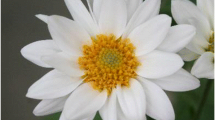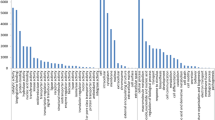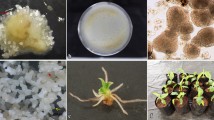Abstract
Carob (Ceratonia siliqua L.) is a caesalpinoid legume tree showing labile sex expression. With the main aims of identifying flower-expressed genes and of developing specific markers, 1,056 clones from a complementary DNA library of carob flowers were bidirectionally sequenced. A total of 1,377 high-quality expressed sequence tags were clustered into 1,096 unigenes. Basic Local Alignment Search Tool and Gene Ontology functional annotation allowed to identify several agronomically important genes, such as those involved in flower development and sexual reproduction, response to stress, galactomannan synthesis, and hormone pathways. Genes involved in the ethylene biosynthesis and response were quantified in developing flowers of three sex genotypes (male, female, and hermaphrodite) using quantitative reverse transcription polymerase chain reaction. The transcript levels of 1-aminocyclopropane-1-carboxylic acid oxidase, acting downstream in ethylene pathway, and Ethylene Insensitive 3 (EIN3)-like, a transcription factor involved in ethylene signaling, were directly correlated with maleness, indicating a possible role of ethylene in carob sex expression. Furthermore, the first set of carob genic microsatellites was developed, which might be useful for genotyping and genetic diversity analysis.





Similar content being viewed by others
References
Afif M, Ben Fadhel N, Khoudja Mohamed L, Boussaïd M (2006) Genetic diversity in Tunisian Ceratonia siliqua L. (Caesalpinioideae) natural populations. Genet Resour Crop Evol 53:1501–1511
Ahlfors R, Lang S, Overmyer K, Jaspers P, Brosché M, Tauriainen A, Kollist H, Tuominen H, Belles-Boix E, Piippo M, Inzé D, Palva ET, Kangasjärvi J (2004) Arabidopsis RADICAL-INDUCED CELL DEATH1 belongs to the WWE protein–protein interaction domain protein family and modulates abscisic acid, ethylene, and methyl jasmonate responses. Plant Cell 16:1925–1937
Ainsworth C (2000) Boys and girls come out to play: the molecular biology of dioecious plants. Ann Bot 86:211–221
Argueso CT, Hansen M, Kieber JJ (2007) Regulation of ethylene biosynthesis. J Plant Growth Regul 26:92–105
Batlle I, Tous J (1997) Carob tree. Ceratonia siliqua L. Promoting the conservation and use of underutilized and neglected crops. 17. Institute of Plant Genetics and Crop Plant Research, Gatersleben/International Plant Genetic Resources Institute, Rome, Italy
Bleeker AB, Kende H (2000) Ethylene: a gaseous signal molecule in plants. Annu Rev Cell Dev Biol 16:1–18
Caruso M, Federici CT, Roose ML (2008a) EST-SSR markers for asparagus genetic diversity evaluation and cultivar identification. Mol Breed 21:195–204
Caruso M, La Malfa S, Pavlícek T, Frutos Tomás D, Gentile A, Tribulato E (2008b) Characterization and assessment of genetic diversity in cultivated and wild carob (Ceratonia siliqua L.) genotypes using AFLP markers. J Hortic Sci Biotech 83:177–182
Chen YF, Etheridge N, Schaller GE (2005) Ethylene signal transduction. Ann Bot 95:901–915
Chen C, Zhou P, Choi YA, Huang S, Gmitter Jr FG (2006) Mining and characterizing microsatellites from citrus ESTs. Theor Appl Genet 112:1248–1257
Dellaporta SL, Calderon-Urrea A (1993) Sex determination in flowering plants. Plant Cell 5:1241–1251
Dhugga KS, Barreiro R, Whitten B, Stecca K, Hazebroek J, Randhawa GS, Dolan M, Kinney AJ, Tomes D, Nichols S, Anderson P (2004) Guar seed b-mannan synthase is a member of the cellulose synthase super gene family. Science 303:363–366
Iordachescu M, Verlinden S (2005) Transcriptional regulation of three EIN3-like genes of carnation (Dianthus caryophyllus L. cv. Improved White Sim) during flower development and upon wounding, pollination, and ethylene exposure. J Exp Bot 56:2011–2018
Jaiswal VS, Kumar A (1980) Sex reversal and fruit formation on the male plants of Morus nigra L. by 2-chloroethylphosphonic acid. J Exp Bot 31:497–500
Kahana A, Silberstein L, Kessler N, Goldstein RS, Perl-Treves R (1999) Expression of ACC oxidase genes differs among sex genotypes and sex phases in cucumber. Plant Mol Biol 41:517–528
Korpelainen H (1998) Labile sex expression in plants. Biol Rev 73:157–180
Krizek BA, Fletcher JC (2005) Molecular mechanisms of flower development: an armchair guide. Nat Rev Genet 6:688–698
Li YC, Korol AB, Fahima T, Nevo E (2004) Microsatellites within genes: structure, function, and evolution. Mol Biol Evol 21:991–1007
Lindqvist C, Scheen AC, Yoo MJ, Grey P, Oppenheimer DG, Leebens-Mack JH, Soltis DE, Soltis PS, Albert VA (2006) An expressed sequence tag (EST) library from developing fruits of an Hawaiian endemic mint (Stenogyne rugosa, Lamiaceae): characterization and microsatellite markers. BMC Plant Biol 6:16
Lokko Y, Anderson J, Rudd S, Raji A, Horvath D, Mikel M, Kim R, Liu L, Hernandez A, Dixon A, Ingelbrecht I (2007) Characterization of an 18,166 EST dataset for cassava (Manihot esculenta Crantz) enriched for drought-responsive genes. Plant Cell Rep 26:1605–1618
Martin-Tanguy J (2001) Metabolism and function of polyamines in plants: recent development (new approaches). Plant Growth Regul 34:135–148
Mehta PA, Sivaprakash K, Parani M, Venkataraman G, Parida AK (2005) Generation and analysis of expressed sequence tags from the salt-tolerant mangrove species Avicennia marina (Forsk) Vierh. Theor Appl Genet 110:416–424
Metzgar D, Bytof J, Wills C (2000) Selection against frameshift mutations limits microsatellite expansion in coding DNA. Genome Res 10:72–80
Miura Y, Hirata M, Fujimori M (2007) Mapping of EST-derived CAPS markers in Italian ryegrass (Lolium multiflorum Lam.). Plant Breed 126:353–360
Mohan Ram HY, Sett R (1982) Induction of fertile male flowers in genetically female Cannabis sativa plants by silver nitrate and silver thiosulphate anionic complex. Theor Appl Genet 62:369–375
Oetting WS, Lee HK, Flanders DJ, Wiesner GL, Sellers TA, King RA (1995) Linkage analysis with multiplexed short tandem repeat polymorphisms using infrared fluorescence and M13 tailed primers. Genomics 30:450–458
Papadopoulou E, Little HA, Hammar SA, Grumet R (2005) Effect of modified endogenous ethylene production on sex expression, bisexual flower development and fruit production in melon (Cucumis melo L.). Sex Plant Reprod 18:131–142
Proite K, Leal-Bertioli SCM, Bertioli DJ, Moretzsohn MC, da Silva FR, Martins NF, Guimarães PM (2007) ESTs from a wild Arachis species for gene discovery and marker development. BMC Plant Biol 7:7
Rozen S, Skaletsky HJ (2000) Primer3 on the WWW for general users and for biologist programmers. In: Krawetz S, Misener S (eds) Bioinformatics methods and protocols: methods in molecular biology. Humana, Totowa, NJ
Rudd S (2003) Expressed sequence tags: alternative or complement to whole genome sequences. Trends Plant Sci 8:321–329
Rudich J, Halevy AH, Kedar N (1969) Increase in femaleness of three cucurbits by treatment with Ethrel, an ethylene-releasing compound. Planta 86:69–76
Saito S, Fujii N, Miyazawa Y, Yamasaki S, Matsuura S, Mizusawa H, Fujita Y, Takahashi H (2007) Correlation between development of female flower buds and expression of the CS-ACS2 gene in cucumber plants. J Exp Bot 58:2897–2907
Soltis DE, Ma H, Frohlich MW, Soltis PS, Albert VA, Oppenheimer DG, Altman NS, dePamphilis CW, Leebens-Mack JH (2007) The floral genome: an evolutionary history of gene duplication and shifting patterns of gene expression. Trends Plant Sci 12:358–367
Thomas DT (2004) In vitro modification of sex expression in mulberry (Morus alba) by ethrel and silver nitrate. Plant Cell Tissue Organ Cult 77:277–281
Tous J, Olarte C, Truco MJ, Ark P (1992) Isozyme polymorphisms in carob cultivars. HortScience 27:257–258
Trebitsh T, Rudich J, Riov J (1987) Auxin, biosynthesis of ethylene and sex expression in cucumber (Cucumis sativus). Plant Growth Regul 5:105–113
Tucker SC (1992) The developmental basis for sexual expression in Ceratonia siliqua (Leguminosae: Caesalpinoideae: Cassieae). Am J Bot 79:318–327
Udvardi MK, Kakar K, Wandrey M, Montanari O, Murray J, Andriankaja A, Zhang JY, Benedito V, Hofer JM, Chueng F, Town CD (2007) Legume transcription factors: global regulators of plant development and response to the environment. Plant Physiol 144:538–549
Varkey M, Nigam RK (1982) Time of application of Niagara 10637 for induction of maleness or femaleness in Ricinus communis Linn. J Plant Res 95:309–315
Varshney RK, Graner A, Sorrells ME (2005) Genic microsatellite markers in plants: features and applications. Trends Biotechnol 23:48–55
Waki K, Shibuya K, Yoshioka T, Hashiba T, Satoh S (2001) Cloning of a cDNA encoding EIN3-like protein (DC-EIL1) and decrease in its mRNA level during senescence in carnation flower tissues. J Exp Bot 52:377–379
Wang KL, Li H, Ecker JR (2002) Ethylene biosynthesis and signaling networks. Plant Cell 14:S131–S151
Yamasaki S, Fujii N, Takahashi H (2005) Hormonal regulation of sex expression in plants. Vitam Horm 72:79–110
Young ND, Mudge J, Ellis TN (2003) Legume genomes: more than peas in a pod. Curr Opin Plant Biol 6:199–204
Acknowledgments
Funding was provided by Research Program MiPAAF-CIPE; FRU.MED., Project PRO.VI.SUD; Publication no. 42.
Author information
Authors and Affiliations
Corresponding author
Additional information
Communicated by J. Dean
Electronic supplementary material
Below is the link to the electronic supplementary material.
Table S1
Carob EST primers that were monomorphic and that produced excess stutter bands or alleles larger than 900 bp (DOC 44 KB)
Rights and permissions
About this article
Cite this article
Caruso, M., Distefano, G., Ye, X. et al. Generation of expressed sequence tags from carob (Ceratonia siliqua L.) flowers for gene identification and marker development. Tree Genetics & Genomes 4, 869–879 (2008). https://doi.org/10.1007/s11295-008-0159-8
Received:
Revised:
Accepted:
Published:
Issue Date:
DOI: https://doi.org/10.1007/s11295-008-0159-8




